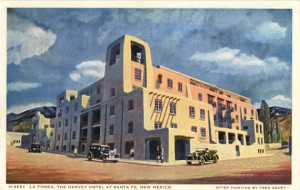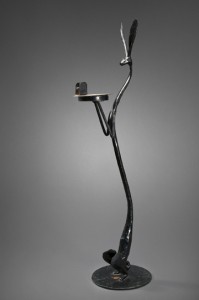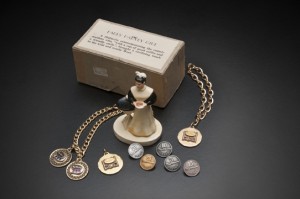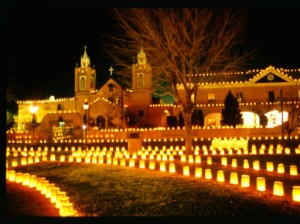
Old Town Plaza, with San Felipe de Neri Church, Albuquerque, 1990 (?). Palace of the Governors Photo Archives HP.2007.20.1052.
In a Dec. 3, 1590, journal entry, Spanish explorer Gaspar Costaño de Sosa mentioned the small bonfires his cohorts had lit to guide a scout back to camp. Luminarias, he called them, thereby casting the first stone in a 400-year-old, northern-versus-southern New Mexico debate over the little paper bags that light up our holiday nights.
“They’re farolitos,” folks north of La Bajada Hill insist.
“Luminarias,” everyone from Albuquerque on down says.
Over the years, even linguists have disagreed. Their arguments for and against fill a fat file at the Fray Angélico Chávez History Library at the New Mexico History Museum. Among the certainties is this: Before the 1872 invention of flat-bottom paper bags, before the ready availability of votive candles, and before electricity and strings of “icicle lights,” New Mexicans marked the paths to their doors and the local church with small, Sosa-style bonfires on Christmas eve—symbolically lighting the way for the Holy Family.
Chinese paper lanterns found their way to Santa Fe via the 18th-century Manila galleons and El Camino Real, but the paper was so fragile that outdoor use was rare. Once cheaper paper bags arrived on the Santa Fe Trail, locals discovered they could fold down the tops, anchor them with a few handfuls of sand, and set a small candle inside for a more subtle display that didn’t deplete the winter woodpile.
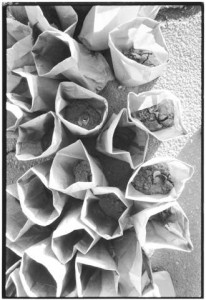
Paper bags with sand and a candle in the bottom, waiting for placement, 1980. Santa Fe New Mexican Collection, Palace of the Governors Photo Archives HP.2014.14.289.
But what to call them? Some folks stuck with luminaria, “light” in Spanish. Others adopted farolito, from “farol,” the Spanish word for lantern. In the 1930s, as more people got the paper-bag bug, newspaper articles dithered, alternately calling them farolitos, linternitas, and farolillos. In 1958, the august New York Times chimed in, but said Albuquerqueans called them farolitos, further confusing the geography.
Before his 1996 death, Fray Angélico himself waded into the debate and essentially concluded, “Whatever.”
Today the bags-and-candles tradition stretches from California to Maine. In Santa Fe, the Christmas Eve farolito walk on Canyon Road is a beloved community event. Head out after sundown to stroll the streets (no cars allowed!) and meet some locals in front of their shops and homes. (Just be sure not to compliment them on their luminarias unless you mean their bonfires. Remember, you’re in the North now.)
As for those plastic versions bedecking rooflines throughout the holiday season, take it from renowned Santa Fe archaeologist Cordelia Snow, whose 1991 letter to the editor cheekily dubbed them “electrolitos.”

